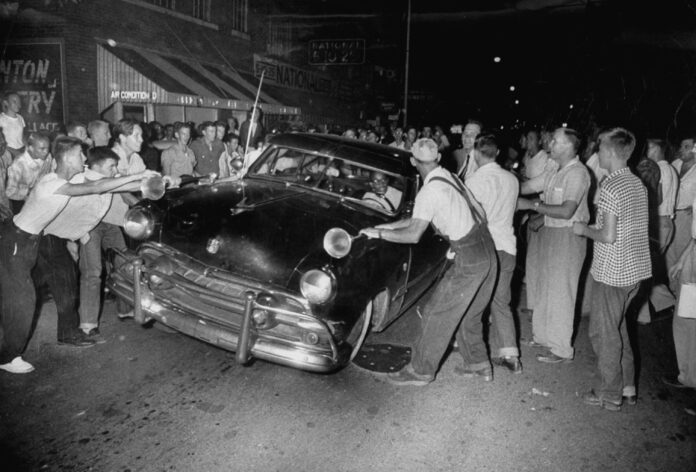Author: Yunis Alam
Date Published: 12 August 2020
Publisher: The Conversation
Link: https://theconversation.com/road-rage-stop-and-search-and-vehicle-stereotypes-why-cars-drive-so-much-racism-141166
As the recent wave of Black Lives Matter protests have shown, racial bias, prejudice and discrimination very much still exists, but has, in some cases, become more subtle and complex in formation over the past few decades. But, as the research for my new book shows, one space where racism is routinely present on the road – specifically when it comes to the type of car a person may be driving.
Driver stereotypes
You might even be familiar with some of the simplistic stereotypes about various types of cars and drivers: from the White Van Man to the Subaru Boy Racer, narratives are created and circulated.
There are stereotypes about certain brands: Audi drivers as aggressive, some convertible models are either “womens’ cars” or said to be “hairdressers” cars – read that as sporty looking on a budget. And of course, the ubiquitous “Chelsea tractor” sobriquet is often used to describe any large four-wheel-drive vehicle in urban areas.
Over time and through repetition these stereotypes become highly meaningful and form shortcuts – underpinned with logic and experience, each reinforcing the other. Such ideas end up seeming normal, accepted and constitute conventional wisdom.
Racism on the road
In my sociology research, I’ve found that racial stereotypes are fairly common on the UK’s roads – particularly in multi-ethnic areas.
Over a period of several years, I spoke with people from various ethnic, gender, class and professional backgrounds. Through interview, observation and participation, the emerging data often painted car ownership as a complex but important indicator of status or success. But, at the same time, for many people, owning what appeared to be expensive cars also posed risks for the driver.
My research shows that narratives around particular types of cars in the hands of particular types of owners were abundant and held as common shorthand.
I found, for example, that if you’re young and of South Asian heritage and you drive an expensive looking car in an inner city, then you run the risk of being stereotyped as a drug dealer. How else, after all, could someone who is not expected to have the life chances to succeed using legitimate endeavour, demonstrate such success?
Similarly, people with cars that happen to be equipped with loud in-car entertainment systems, may be seen as unruly, self-indulgent and possibly antisocial.
Changing lanes
In my new book Race, Taste, Class and Cars I look at the complexity of car acquisition, ownership and maintenance. Part of my book is dedicated to car modification – and looks at the experiences of owners who tweak their car’s performance, or aesthetics to improve its overall style, in turn adding a layer of creativity.
But I’ve found that instead of seeing car customisation and modification as a creative, artistic endeavour, those who invest emotionally and economically into the look, feel and sound of their cars are often made to feel they are problematic troublemakers – and doubly problematic if they are not white.
At the heart of my analysis is the fact that race and class-based prejudices are given license to be enacted on the road with such frequency that they become rational, banal, accepted and – as things stand – unlikely to be challenged.
For example, a prestige car with tinted windows and black occupants in a largely white and affluent district may have been something of a flag – hence the stop.
There are many similar cases, some of which have lasting effects on those suspected by police officers as criminal, partly because of the false assumption that the car they drive seems only attainable through illicit means.
It is clear that what is needed is a shift in cultural attitudes as well as an acknowledgement of these now racially primed shortcuts for what they are. In turn, policing strategy especially within multi-ethnic areas needs modification to ensure practices aren’t just a result of stereotypical prejudice.
I think with such a prevalent interplay between politics, economics, and society that automakers have to address, I wanted to dedicate a few articles in my focus section to addressing equity and diversity on the subject matter. I think this article helps me get a sense of what POC’s experiences with new vehicles are, and what could be done in order to better address this stigma. It’s key to note this as we move forward with the design process, because ultimately these biases are still going to remain in place as cars shift towards more autonomous technology. I think with new makes of vehicles are going to come new stereotypes, and we need to know what the current ones are in order to make educated predictions about what they may look like in the future.
Alam, Y. (2021, August 25). Road rage, stop and search and vehicle stereotypes: Why cars drive so much racism. The Conversation. Retrieved September 26, 2021, from https://theconversation.com/road-rage-stop-and-search-and-vehicle-stereotypes-why-cars-drive-so-much-racism-141166.




